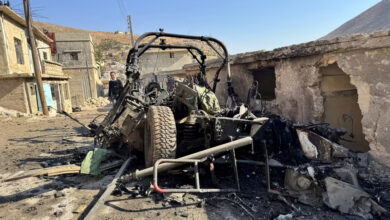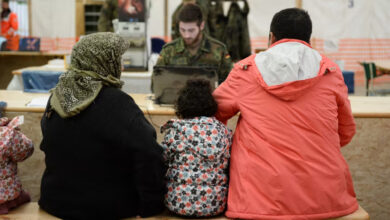LONDON — The popular upheaval in Syria is growing bolder and the cracks in the establishment are getting deeper — yet there is a long and bloody road ahead if protesters are to unseat President Bashar al-Assad and end his family's 40 years in power.
The price of stalemate is rising daily: sectarian mayhem, a growing protest movement and a faltering economy, with no sign that Bashar and his minority Alawite clan are considering an exit strategy after four decades in power.
Yet so far, there is no sign of a tipping point that would assure success for protesters, as in Tunisia and Egypt, where millions took to the streets to topple autocratic leaders.
"The situation has not reached a critical mass," said Patrick Seale, biographer of Bashar's father, Hafez al-Assad.
"Damascus hasn't risen, the security services haven't split yet, the economy hasn't collapsed. The regime looks weak and the opposition looks weaker," he said.
Sectarian killings in the city of Homs this month may be a foretaste for a country with an ethnic and religious mix and a long history of repression by the Alawite-led security forces.
The Alawite sect, an off-shoot of Shia Islam, is a minority in Syria, which has a Sunni Muslim majority, as well as smaller numbers of Druze, Christians and non-Arab Kurds.
A group of Alawite men, including four security men, went missing on 14 July. The bodies of four of them were found killed. Some Alawites from their neighborhood in Homs took to the streets, torched and destroyed shops belonging to Sunnis.
The danger of sectarian strife is real, analysts say. It might even appeal to the authorities — and some of their opponents — as a way to break the deadlock. But it carries high risks for the Assad dynasty, as well as the opposition.
"This is a dangerous strategy for a regime trying to survive," said Eugene Rogan, director of the Middle East Centre at Oxford University. "You watch your army disintegrate if sectarianism becomes an issue."
Analysts say the Homs killings were provoked by a ferocious security clampdown, including the arrest, disappearance and torture to death of hundreds of men. Islamists, long persecuted by the security forces, have their own axe to grind.
"The security solution hasn't worked. The regime has decided to go for civil strife because it senses that it is losing. The protests are spilling over and spreading to the capital," said a Damascus-based Arab journalist who declined to be named.
Alawite villagers say authorities have been arming young men to fight the insurgency. Mutilated bodies of some Shabbiha men, handed over by security forces to their families for burial, served to incite sectarian hatred in those villages.
Sectarian paranoia is evident, with Assad trusting only two elite units commanded by his brother Maher — the 4th Armored Division and the Republican Guard — as well as secret police and Alawite militia, known as Shabbiha, to deal with dissent.
"The coherence (of the security forces) is already in question. Sectarianism is already a problem, the loyalty of other units cannot be counted on," Rogan said.
While the authorities blame the upheaval on a "bunch of Islamists," the reality appears more complex.
Some Syria-watchers say the protest movement is driven mainly by youths and includes rural Sunni tribes, nationalists, leftists, secularists and also Islamists, united in their goal of overthrowing an autocratic and corrupt government.
Geographically, the protests have spread since March to many rural and tribal regions, cities such as Hama and Homs, and even to Damascus, although not on a huge scale in the capital.
Security forces and Shabbiha militiamen, armed with metal bars, are everywhere. The army has deployed tanks around the main cities to keep out protesters from the countryside.
"The savagery of the regime has increased 180 degrees. The hostility against it has massively increased too among ordinary people, not just protesters. There are widescale arrests in all areas, in cities and villages," the Syrian journalist said.
Residents said the Alawite units, though overstretched, have stepped up their offensive and are showing resilience in facing the growing demonstrations. The protest movement, however, is growing and showing no sign of dying down, residents add.
In a country where once no one dared utter a word against the president, chants such as: "Bashar you butcher we won't rest until we bury you" show how fearless the activists have become.
Graffiti on rubbish bins read: "Bashar: this is your final grave."
Toppling the system, analysts say, is hazardous because of Syria's power structure under which Alawites hold key posts in the military and Assad family insiders run the key security bodies, tying senior officers closely to Assad's own fate.
Sarkis Naoum, an expert on Syrian affairs, said Assad was not likely to be overthrown quickly, but the conflict could develop into a bloody civil war.
"It is not clear how it would evolve and how much time it would take. The regime cannot win and also the opposition cannot win either," said Naoum, a columnist at Beirut's an-Nahar daily.
What complicates the Syrian scene is that the Assads will fight to the end rather than leave because they fear that their family and their sect would be targeted under Sunni rule.
"The Assads won't relinquish power. They are refusing reform because it will make them have to give up power," Naoum said.
Rogan said that Assad's departure was not imminent. "It is a long way before we reach the point where Bashar has to go. The regime is a lot stronger than people like to think but Assad is weak and has no sense of leadership."
The protests have virtually crippled Damascus. Shops open for a few hours during the day and close early. Business activity is grounded and many people have lost their jobs.
The city, which once buzzed with night life, is tense and eerie after dark. Signs of stretched resources and a strained economy are very evident.
The Syrian economy could prove to be Assad's curse. With no end in sight to the crackdown on protesters, the country's key revenue streams look shattered. A more marked decline in Syria's economic health may force the regime to fall.
After growing at an average of 5 percent over the last five years, the economy is forecast to contract as much as 3 percent this year as tourism, which accounts for 23 percent of Syria's hard currency earnings, and foreign investment grind to a halt.
With hotels almost empty and the growing likelihood of oil sanctions, Syria is desperately trying to retain local and foreign currency by increasing interest rates on deposits and curbing foreign currency sales.
Tehran, which regards Syria as a close ally in a mainly Sunni-dominated region suspicious of non-Arab Shia Iran, is reported to have come to his help in funds and expertise.
Iran is considering offering US$5.8 billion (3.5 billion pound) in financial help, French business newspaper Les Echos said.
Iran, which quashed its own pro-democracy youth movement after President Mahmoud Ahmadinejad's re-election in 2009, has sent experts to help the Syrian authorities monitor and jam satellite communication and the Internet, according to Ausama Monajed of the Syrian opposition.
The opposition said the government had been finding it hard to monitor the activists' communications until the Iranians stepped in, providing authorities with Chinese and North Korean equipment to intercept and eavesdrop on conversations.
Monajed, spokesman for the Syrian opposition in Europe, said the opposition is lobbying to raise funds and rally world opinion to slap more sanctions against Assad and his aides.
While close observers of Syria weigh the multiple scenarios, none of them appears to have a neat end.
"The sooner this mafia is gone the better," Rogan said. "A lot worse can happen trying to get rid of these guys than we have seen already."
Seale said: "The more blood is spilt the more difficult is to find a solution. There has to be a negotiated solution of sort. If there is no solution there will be a civil war."




